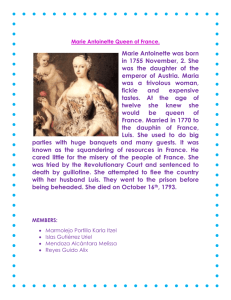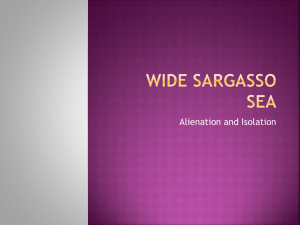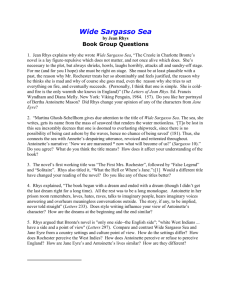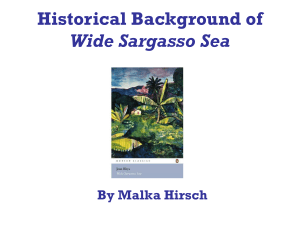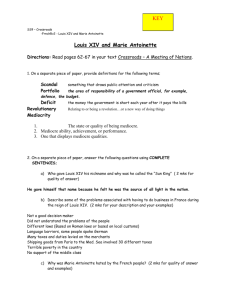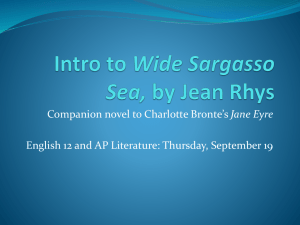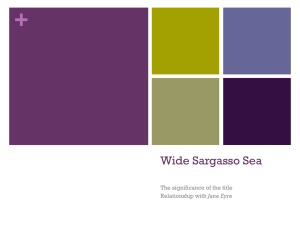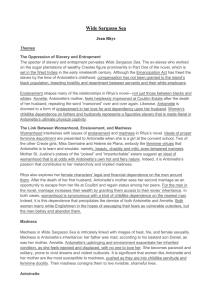DOUBLE COMPLEXITY IN JEAN RHYS'S WIDE SARGASSO SEA
advertisement
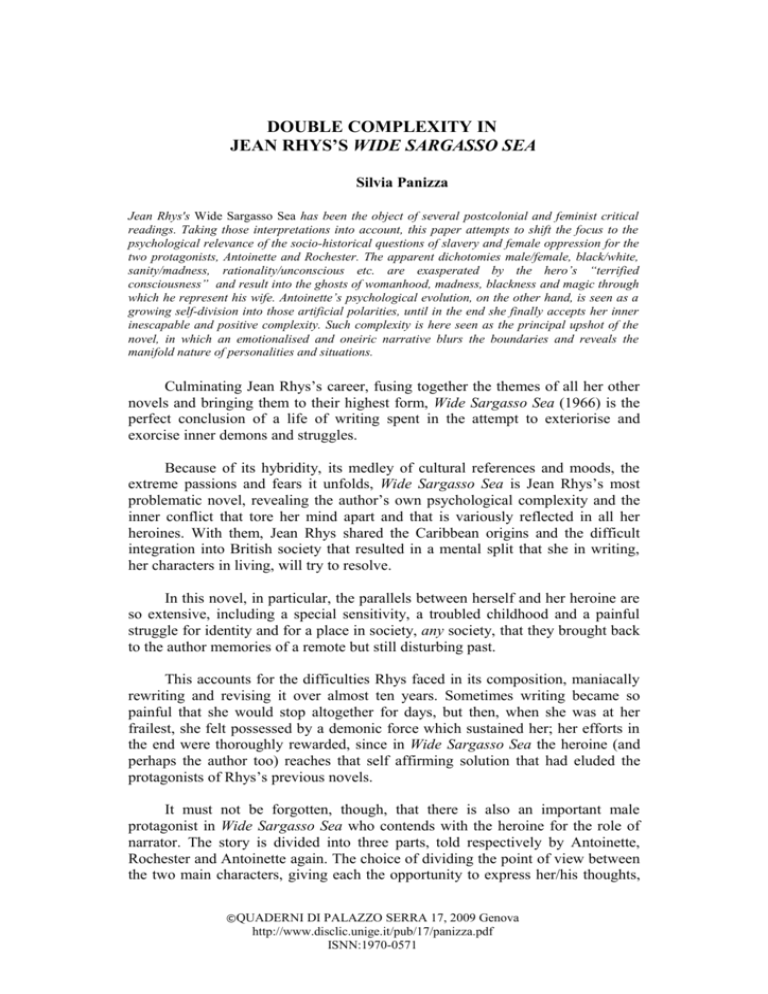
DOUBLE COMPLEXITY IN JEAN RHYS’S WIDE SARGASSO SEA Silvia Panizza Jean Rhys's Wide Sargasso Sea has been the object of several postcolonial and feminist critical readings. Taking those interpretations into account, this paper attempts to shift the focus to the psychological relevance of the socio-historical questions of slavery and female oppression for the two protagonists, Antoinette and Rochester. The apparent dichotomies male/female, black/white, sanity/madness, rationality/unconscious etc. are exasperated by the hero’s “terrified consciousness” and result into the ghosts of womanhood, madness, blackness and magic through which he represent his wife. Antoinette’s psychological evolution, on the other hand, is seen as a growing self-division into those artificial polarities, until in the end she finally accepts her inner inescapable and positive complexity. Such complexity is here seen as the principal upshot of the novel, in which an emotionalised and oneiric narrative blurs the boundaries and reveals the manifold nature of personalities and situations. Culminating Jean Rhys’s career, fusing together the themes of all her other novels and bringing them to their highest form, Wide Sargasso Sea (1966) is the perfect conclusion of a life of writing spent in the attempt to exteriorise and exorcise inner demons and struggles. Because of its hybridity, its medley of cultural references and moods, the extreme passions and fears it unfolds, Wide Sargasso Sea is Jean Rhys’s most problematic novel, revealing the author’s own psychological complexity and the inner conflict that tore her mind apart and that is variously reflected in all her heroines. With them, Jean Rhys shared the Caribbean origins and the difficult integration into British society that resulted in a mental split that she in writing, her characters in living, will try to resolve. In this novel, in particular, the parallels between herself and her heroine are so extensive, including a special sensitivity, a troubled childhood and a painful struggle for identity and for a place in society, any society, that they brought back to the author memories of a remote but still disturbing past. This accounts for the difficulties Rhys faced in its composition, maniacally rewriting and revising it over almost ten years. Sometimes writing became so painful that she would stop altogether for days, but then, when she was at her frailest, she felt possessed by a demonic force which sustained her; her efforts in the end were thoroughly rewarded, since in Wide Sargasso Sea the heroine (and perhaps the author too) reaches that self affirming solution that had eluded the protagonists of Rhys’s previous novels. It must not be forgotten, though, that there is also an important male protagonist in Wide Sargasso Sea who contends with the heroine for the role of narrator. The story is divided into three parts, told respectively by Antoinette, Rochester and Antoinette again. The choice of dividing the point of view between the two main characters, giving each the opportunity to express her/his thoughts, ©QUADERNI DI PALAZZO SERRA 17, 2009 Genova http://www.disclic.unige.it/pub/17/panizza.pdf ISNN:1970-0571 Double complexity in Jean Rhys’s Wide Sargasso Sea gives the novel the additional value of presenting facts in a double perspective, showing Rhys’s ability to understand and express different viewpoints. Moreover, through the space given to the apparently negative character, it becomes apparent that Rochester himself is endowed with a complex and interesting personality, made up of those very same forces (though in very different proportions) that divide the self of Antoinette. An exceptionally resonant novel, Wide Sargasso Sea tackles various fundamental themes such as race and identity, gender and politics, at the same time as it gives voice to extremely varied ways of feeling and unresolved conflicting emotions. Precisely because of its abundance of themes, since its publication it has been the object of differing critical readings, some stressing its feminist vindication, others contemplating its representation of colonialism and racial politics. When it came out, in 1966, it was first welcomed by Caribbean critics who argued that questions of race, slavery and colonialism in the novel were of greater interest than its psychological and sexual content. Conversely, feminist readers1 in the following decade focussed on the portrayal of the role of the woman and its connections with slavery, speculating that Jean Rhys intended to show that the two groups were equally oppressed. Postcolonial critics2 attempted to draw a line between the novel’s British and African cultural inheritance, situating, for instance, the influence of Jane Eyre, which provided inspiration for Wide Sargasso Sea, in the first area, and the scenes of magic and of slaves’ daily life in the second. The conflicts between blacks and whites, men and women, colonialists and colonised, can, in this novel, also be traced back to the tension between two fundamental, primary opposing forces: reason and emotion, rationality and the unconscious have always been involved in an endless struggle, each trying to win over the other but neither ever succeeding. These forces are represented in the novel as emerging through a number of themes and images, including those mentioned above, so that questions of gender and female oppression, for example, are not just dealt with per se, but also as representing more abstract issues. On the one side of the “battle-line”, then, there is reason, Europe and civilization, adult age, white skin, patriarchy and masculinity; on the other, passion, the Caribbean and the “exotic” colonies, childhood, black skin, matriarchy and femininity. These are the forces that clash within the mind of Antoinette, so that the significance of the outer tensions represented in the novel is heightened in the light of their impact on the psyche of the protagonist. Thus the political and social struggles in Wide Sargasso Sea can be viewed both as influences on Antoinette and, also, as externalisations of the contrasts in her mind, great impediments in her restless search for identity. We have suggested that Antoinette carries within herself two opposing worlds, but it would be more accurate to say that her mind is suspended between those two worlds, so, ultimately, it belongs to neither. Though striving to find a 2 Silvia Panizza place in one culture or the other, she is repudiated by both, and must accept that her abode is in a no-man’s-land, a country inhabited by herself alone, since the complex mixture of characteristics that make up her personality cannot be ascribed to any nation. This is the great tragedy of Wide Sargasso Sea, the troubles of an identity “at sea” between two continents and unable to reach either shore. The Sargasso Sea between the Caribbean and Europe is so wide for Antoinette that she is unable to cross it, so she remains trapped in the middle of it, just like the ships that were becalmed in its shallow waters. Since most of the critical attention, as mentioned above, has been devoted to “external” problems, such as race, gender and colonial politics, this essay will concentrate on the psychological relevance of those conflicts, examining the reasons for the internal division that torments the heroine. The interpretation of its solution, represented in the ending of the novel, depends on the assessment of this question. Some consideration will also be given to the problematics of the character of Rochester, indicating the factors of complexity in him and, subsequently, the reasons for his reactions. 1. Fighting with spectres Wide Sargasso Sea is a novel of shifting boundaries and changing perspectives, communicating with intensity to the reader. The characters, however, find it harder to accept that complexity as natural, most of all when they find it within themselves and the people they live with. The role of Rochester, though often dismissed as purely negative, is in this respect fascinating, since the composite nature of this character highlights the inescapable complexity that the novel portrays. He is, like the heroine, unsettled by conflicting emotions, not one-sided or romanticised as in Jane Eyre, but troubled and multifaceted. Here, in fact, he is “not a bad man”, as Christophine notices, and his soul is not just unfeeling and unkind. He can be gentle and sympathetic, like on the day of departing from the West Indies, when he tries to comfort Antoinette because, after all, he loves her – a little. The fact that Rochester may have cared for his wife may be surprising to a reader of Jane Eyre, but it fits perfectly within a novel that reveals the infinite nuances of people’s minds. The most significant emergence of unwanted passions inside Rochester takes the shape of the forbidden, as well as irresistible, sexual desire he feels for his wife (despite blaming it on her “mad coaxing”), in the passionate nights together and in the torrid lazy afternoons, a desire so extreme that even a dress stretched on the floor makes him feel “savage with desire” (WSS, p. 56). His discovery of the pleasure of the senses also appears when, despite his initial loathing of orchids and frangipani (flowers are symbolically loaded images in the novel), he grows to relish the smell of the “flowers that open at dark”, inhaling their scent in guilty solitude. The powerful womanhood of his wife and her native 3 Double complexity in Jean Rhys’s Wide Sargasso Sea land, which is her domain, rouse in him a mixture of attraction and repulsion; unfortunately, the outcome will not be acceptance but blind fear. If Rochester finds it so hard to escape the nightmarish female world that the Caribbean is to him, it is also because he has little to oppose in terms of masculine values. Similarly to Antoinette, whose surname is scattered across the island through boys and girls of different colours, adding to the uncertainty of her paternal origins, Rochester cannot claim a strong and unquestionable male lineage. As G.C. Spivak3 has suggested, he lacks “the name of the father”: we call him Rochester because that is the name we learn from Jane Eyre, but in Wide Sargasso Sea the patronymic is never mentioned. For him, too, the patriarchal law which he often invokes is a cause of suffering, taking the shape of an inheritance law which conveyed all the family property to his elder brother. The unexpressed rage against his father makes him an Oedipal figure who, deserted by paternal assurance, directs his rage at other people while he unwittingly harms himself as well; his few attempts at turning against his father are destined to fail from the start, and he will only be able to put his anger into words that will never be read, as in the accusatory letter not written4 and in the one not sent. Frightened by the irrationality that emerges within himself and by the weakness of his claims on reason and European values, Rochester will, in his confrontation with Antoinette, emphasise the “Western” traits in him and, at the same time, perceive her as his perfect opponent, a specimen of the “other side”, not knowing that she also belongs to both. In her he will embody all that he fears, the world he feels threatened by, the feelings and passions that his rational mind will not acknowledge. In his reaction he re-enacts the anxiety his colonial class suffered from when decolonization began. Kenneth Ramchand has examined this phenomenon from a politicalhistorical point of view in an essay entitled “Terrified consciousness” (1969).5 His main claim, drawn from the anticolonial thinker Frantz Fanon,6 is that the radical change in the whole colonial society, which occurred with decolonization, resulted in a fundamental insecurity and sense of danger haunting the minds of both the colonizers, who saw the empire they had created collapse, and the white Creoles, whom the natives identified with the Western invader. Though in 1833, the year Wide Sargasso Sea begins, decolonization was still in embryo, planters could see the first signs of the upsetting of the social order in the black revolts and in the Emancipation Act, as well as in the planters’ beginning to lose power and prestige – a downfall visible in the character of Mr Luttrell, the Cosways’s neighbour, who drowned himself after the slaves of his plantation were freed. The envisaged revolution, as a fated tragedy, not yet realised but hanging over them, frightened the colonisers sufficiently for their minds to lose stability. Likewise, after much effort at appropriating and taming the wildness of the West Indies, the Englishman in Wide Sargasso Sea is defeated by his own mind giving vent to what it dreads most – the unconscious and sensuality – through a 4 Silvia Panizza series of spectres, all connected with his wife, externalised images of what he would most strongly reject. These “ghosts” are nothing but the embodiment of the most distressing fears of the Western man: blackness, bringing back the menace of a race despised but never really subdued; madness, reminding a sane man of the precariousness of human rationality; womanhood, from time immemorial threatening patriarchal power and associated with feelings and emotions, which were considered disreputable as well as dangerous for a “civilised” European. Lastly, when the delusion has become complete, the real ghost arises, imagined as a zombie or soucriant and connected with the magical world of sorcery and obeah that the Caribbean seems to be in foreign, ill-informed eyes. If Rochester sees all this in his wife, it is because these four categories often overlap, all being associated with one particular, “dark” and “irrational” set of powers. The basic frightful force appears to be most manifest in femininity, which draws wider associations with the other themes. Even Caribbean lush nature, in Rochester’s eyes, is female, with its fertile land and overabundant, violently coloured flowers. “Everything is too much, [...] too much blue, too much purple, too much green. The flowers too red, the mountains too high, the hills too near” (WSS, p. 39), he muses, riding towards his honeymoon house in the Windward Islands, distressed by the sensuous fecundity of the place. Antoinette’s sexuality appears to him at the same time as threatening and enticing, growing more and more disturbing as he comes to connect it not only with womanhood, but also with blackness and madness. After trying hard to reject that sexuality which his puritan ethics condemn as wrong and contaminating, Rochester associates his wife’s sensual behaviour with her alleged black blood. It was a widespread legend among Europeans at the time that black women were animated by an unbridled libido, a belief inflated by the stories that circulated exaggerating the illicit relationships between planters and their black servants. Derived from this prejudice was the stereotype of the black woman as “whore” which, together with the cliché of the black “mammy”, sums up the representations of blackness that were then common among Westerners. Therefore, Rochester’s doubts about his wife’s ethnicity appropriately emerge through his alarmed vision of her sexual behaviour, also seen as the means of propagating the ghost of the black race. Antoinette’s free sexuality leads her husband to suspect her not only of being a mulatto, but also of being mad. This apparently preposterous correlation was typical of the least advanced but unfortunately most popular fringes of Victorian medicine, which held that all women suffered from hysteria to some extent and that this disease was caused by the movements of the uterus and exasperated by any excess of emotion. In this way femininity, emotions and sexuality were linked to each other and condemned as causes or symptoms of a disorder. Rochester’s mindset is deeply embedded in his time and culture, acting out 19th century misogynistic theories. Lastly, associated to the other three themes is magic, here obeah, practised by Antoinette’s nurse Christophine and taking on menacing, sinister tones in 5 Double complexity in Jean Rhys’s Wide Sargasso Sea Rochester’s mind because it escapes rational explanation more than anything else. Regina Barreca, in “Writing as Voodoo”, introduces the connection between blackness, madness, magic and female writing: in her essay Barreca describes voodoo as “the residual power of the vanquished”,7 pointing out how the sorceress, the hysteric and the woman artist all defy authority, being animated by the same “desire for disorder or rather for counter order”.8 That may be an accurate explanation for the defensive mental and actual behaviour of the Englishman, and of his attempts to silence and shut out those potential sources of subversion. If Rochester, the representative of a Victorian repressive culture, is so eager to identify these “unconscious forces” as different, external, other from himself, it is because by condemning them he apparently situates himself safely on the other side. Such a simplifying operation is of course destined to fail, and the hero will be the very character in Wide Sargasso Sea whose defeat is most bitter and complete. 2. An impossible integration After briefly examining some of the main themes of Wide Sargasso Sea as emerging from the viewpoint of a frightened male Eurocentric imagination, attention will now be devoted to the real focal point of the novel, Antoinette’s personality and psychology. The strong femininity, irrationality and sensuality that Rochester detects in her are indeed there, although her husband, in his paranoid anxiety, exasperates that side of her well beyond its extent, to the point of seeing her as a mad witch. What Rochester does not realise, however, is that those qualities are merged with others that oppose them, in a mélange of European and Caribbean, rational and irrational traits. Antoinette does not belong exclusively to one world or the other, on the contrary, both cultures have left a peculiar mark on her: her blood is half European and half Caribbean and she has an over-imaginative, childish mind as well as an attraction for European comfort and control. As she can feel these opposing forces within herself, she strives to find a place in one universe or the other, trying to divest herself from all that is not purely White or purely Black. Society taught her that different cultural elements and diverging feelings cannot coexist, leading her to believe that her inner complexity is in fact a mental illness, some sort of schizophrenia. What nobody in the story seems to understand is that those two polarities are necessary to each other, one keeping the other alive by its very opposition. Whiteness and blackness, dreams and reality are all sides of one composite but whole universe, so it is not necessary, but even dangerous, to make a clear-cut choice between them. Such conception, however, was far too tolerant and relativistic for nineteenth century culture, while when Jean Rhys wrote Wide Sargasso Sea it was becoming an increasingly respected notion. The inner struggle is one of the most fascinating and, I believe, crucial problems of the novel. All questions of race, gender and emotion mentioned 6 Silvia Panizza above have an intoxicating influence on Antoinette’s psyche and emerge as the opposites that cause the dramatic split within herself, complicating the recognition of her identity. Until she finally accepts their coexistence. The psychological disorientation and emotional confusion that make Antoinette’s understanding of herself so difficult are then due to both internal and external factors: tormenting her from within is a complex personality, passionate yet restrained, spontaneous yet meditative; surrounding her is a mixture of complicated situations, from the political tumults that mark the beginning of decolonization to the instability of a collapsing family. There is, then, nothing and nobody to help Antoinette in her quest for identity, but there is much against her. Her origins, to begin from the beginning, are missing. Not only is her surname uncertain as a result of her father’s alleged promiscuity, but she is also given another patronymic when her mother remarries, so that she finally has, significantly, one Creole and one English name. Having lost her father at an early age, it is her relationship with her mother, the fundamental female who should act as model and support for her, that becomes crucial in her development. Firstly, as a model or as the person whose behaviour and life Antoinette’s opposers accuse her of being destined to replicate, she is a thoroughly negative one: selfish, vain, cold, weak to the point of letting others imprison and abuse her. Nor is she successful as a comforting and nurturing mother, as her affection is totally devoted to Antoinette’s brother Pierre and all the daughter receives from her is cold indifference or even, on a few occasions, downright rejection. This is at the heart of Antoinette’s insecurity and of her subsequent difficulty of forming satisfactory relationships; the recollection of that primary act of rejection will haunt Antoinette throughout her life and, like a nightmare, will be enacted over and over by most of the people she will care for: her black friend Tia, the mulatto children, Rochester. The exclusion from both white and black society defines her outcast status, a condition that she will be unable to escape and will grieve her beyond endurance. It is from her mother, besides, that Antoinette inherits part of her frailty and insecurity, the typical weaknesses of the “white girl” that affect Annette. They will be manifest in Antoinette’s desire for comfort and protection, false, artificial needs that blind her and direct her to ill-advised choices with miserable consequences.9 Nonetheless, Antoinette’s character is stronger than her mother’s and this difference becomes apparent in the crucial moments when their destiny is to be decided: Annette gives herself up to a madness which is imposed on her rather than real, and she will let people do as they like with her until the moment of her death. Antoinette, on the contrary, does not give up: raging and screaming, she will fight to the end to re-assert her identity, ready to take the extreme step of self-sacrifice to reclaim her freedom and her self. The difficult relationship between mother and daughter, influencing Antoinette’s feelings and actions even in her adult life, has been investigated by Victoria Burrows.10 She argues that the repeated acts of rejection on the part of Annette11 create a trauma in her daughter, whose reaction is to develop strategies 7 Double complexity in Jean Rhys’s Wide Sargasso Sea of dissociation (hence the double identity) and withdrawal (taking refuge in a mental world to escape the evils of reality). The theory of Antoinette’s selfdefensive withdrawal from reality seems to partly justify the dream-like quality of most of Antoinette’s narrative, where it is dreams and emotions, not facts, that matter. The Caribbean setting, with its uncertain and controversial history, is particularly relevant for this analysis. Along with a missing mother, whose presence would have allowed Antoinette to feel part of a family and therefore of a shared tradition, there is also a missing history, contributing to the sense of being uprooted that afflicts the protagonist. Annette harshly turns down her daughter’s questions about the past and as a consequence Antoinette herself will no longer wonder about it, dismissing every issue concerning it by saying: “all that is long ago”. This attitude towards history is shared by the black servants: Baptiste, for instance, refuses even to speak of the road that was once near Granbois and that had been built by the colonisers. Understandably enough, they all attempt to mentally blot out the dark years of slavery that they (including Antoinette) would rather had never existed. As a child, Antoinette senses that her inability to track down her origins, either through history or through a family, also complicates her search for identity, especially at a time in life when her sense of selfhood is still dim. But things only worsen later on, when other, external forces concur in driving the extremes of her already conflictual personality even further asunder. An additional cause of confusion is, of course, her unclear position in the West Indian society, which leads to the double scorn she is constantly subjected to, both from the white population and from the black, even from the mulatto, so there is absolutely no place for her. Moreover, the young people she grows up with and to whom she compares herself are of both African and European origin, so Antoinette finds herself caught between black and white paragons: first, black Tia, whom she admires for her strength; later, the De Plana sisters, so faultless and so European, models of old-world refinement and grace. It does not help her that in the West Indies racial distinctions had for a long time been blurred as a result of miscegenation. The novel gives ample evidence of this as most of the characters have both black and white features and some are real “half-blood”; all this makes it harder for Antoinette herself to choose her own status. For her, in fact, ethnicity seems to be rather a matter of choice than of inheritance, a metaphoric relation, as Lee Erwin12 has defined it, tied to a way of living and behaving rather than to genetics. A fundamental scene, illustrating Antoinette’s complex relationship with the black population, is that of the ex-slaves’ revolt, also paralleling the episode in which Antoinette sets fire to Thornfield. There, as most feminist readings have claimed, the heroine’s rebellion towards Western patriarchal oppression seemingly replicates the slaves’ retaliation against Coulibri estate, the symbol of European mastery.13 It is during the night of the revolt, when the black people 8 Silvia Panizza confront the Cosway family in a reversal of power relations and Tia throws a stone at Antoinette, that the heart of the conflicting black/white relation emerges most forcefully: Then, not so far off, I saw Tia and her mother and I ran to her, for she was all that was left of my life as it had been. We had eaten the same food, slept side by side, bathed in the same river. As I ran, I thought, I will live with Tia and I will be like her. Not to leave Coulibri. Not to go. Not. When I was close I saw the jagged stone in her hand but I didn’t see her throw it. I did not feel it either, only something wet, running down my face. I looked at her and I saw her face crumple up as she began to cry. We stared at each other, blood on my face, tears on hers. It was as if I saw myself. Like in a looking-glass (WSS, p. 23). This is not only a scene of rejection and violence, but also, at the same time, one of identification. It reveals the manifold reasons lying behind an action and the different influences that act on people in crucial moments. Helen Tiffin14 reads the episode as the manifestation of the sense of communion between the black and the white girl, the image of the looking glass acting as a means of union, showing how both children are victims of the world they live in, and their mutual attack (after being cheated of two pennies by Tia, Antoinette enacts almost mechanically the white prejudice, calling her “cheating nigger” (WSS, p. 8)) is but a product of their society and of what they have been taught. Further signs of the proximity between Antoinette and the Blacks can be detected in her habit of holding her left wrist with the right hand, in her red and swollen wrists after the fight with Richard towards the end of the novel (both images reminding one of slaves’ cuffs), in her being shipped, in fetters, to her prison over the ocean, like slaves from Africa many years before. Or in the fact that she is literally bought for profit and appropriated, both physically and culturally, and given a new, more English name.15 It must not be forgotten, though, that Antoinette’s feelings towards black people are never univocal, something that underscores the thesis that her personality is in constant fluctuation between two worlds. On the other side, there is her sense that being white means respectability and wealth, while her education warned her that growing up “like a nigger”, as she seemed to be doing, was contemptible in a white girl and would make her unfit for society. Albeit only partly accepted and hardly internalised, such conceptions do operate in her, mostly at an unconscious level, emerging for instance when, after seeing her mother abused by a black couple, she turns against Christophine calling her “black devil”, a reaction that appears to be automatic, based on what she has just seen and on a phrase she must have heard many a time, rather than the result of a personal reflection on racial matters. This problem may be solved only through a combination of the two opposite views of identification and rejection. Antoinette, as a white Creole who grew up among black people but was born in a family where European values dominated, 9 Double complexity in Jean Rhys’s Wide Sargasso Sea strongly feels the contrast between the two cultures while showing that racial difference is just a cultural construct, as the children’s indecisive behaviour demonstrates. Rejection on Tia’s part is then only on the surface. Deep down, as Antoinette feels, they are but two children who would see no difference in each other and no harm in playing together. Finally, as the person who will definitely mark Antoinette as an outcast in European society, comes Mr Rochester, who is suspicious of her from the first and misunderstands her completely, widening the chasm inside her. On the one hand, he accusingly implies that she is a sensuous black savage, wild because of her enjoyment of the open air and her familiarity with the island’s lakes and mountains, lustful because of her giving herself to him unrestrainedly. On the other, he imposes on her a European identity and a European name, striving to persuade her that she is the submissive English wife he would want her to be. 16 He goes so far in this as to compare his wife to a zombie, a product of obeah magical rituals, which was characterised by a marked absence of thought and will.17 A description of a zombie would match with alarming precision Rochester’s portrayal of Antoinette: cold hands, red eyes, a connection with death emerging in her night talks, always revolving around that subject,18 and culminating in his covering the body of his wife “as if I covered a dead girl” (WSS, p. 88). By depriving her of her will, as sorcerers do to zombies, Rochester controls and subjugates his wife, just as slave-owners did with their slaves.19 Dividing her into raving black woman and tame white girl, Rochester commits a fatal mistake, being unable to understand that she may comfortably be both: the frail rose on their honeymoon breakfast tray, with its petals falling as he picks it up, and the red flamboyant flower. Thus, finally, Antoinette comes to perceive with acuteness two jarring identities within herself, so the inner conflict that has accompanied her all through her life reaches its climax. A.B. Simpson, in Territories of the Psyche, exasperates this idea of division in psychiatric terms, talking of schizoid paranoia. Emphasising, like Burrows, the role of the mother, Simpson argues that Antoinette’s mind operates in a simplifying way, trying to reduce everything to two basic opposites: primarily, an all-denying mother and an all-giving maternal substitute, Christophine, whom she tends to idealise. She then replicates this pattern in every following experience, separating love and hate with clear-cut boundaries. If Antoinette oversimplifies, however, it is not she but her husband who gives voice to a stereotyped view of things based on previously formed assumptions. The opposites in the novel, besides, should not be taken at face value: it must not be forgotten that the ability to create a fictive world where nothing can be defined in univocal terms, where not even reality can be marked out is one of Rhys’s principal merits. All forces and passions intermingle 20 in this novel and the main characters are moved by manifold and very different motivations. Instead of judging, of arbitrarily tracing simplistic lines of division, Antoinette only tells facts as she remembers and as she feels them, in a dreamlike and emotional 10 Silvia Panizza narrative that shows how in the unconscious or semi-conscious all contours are indistinct and the logic is a different, personal one. Dreams and emotions are, indeed, the very substance of Wide Sargasso Sea, and it will be through these means that the revelation of the heroine’s true identity will come to light. 3. The self in the middle sea It is in Part Three, the most problematic and stylistically disjointed section of the novel, that the meaning of the whole seems to be decided. On account of its importance and elusiveness, critics have argued most vehemently over this part, bringing forth disparate interpretations. The dreamlike quality of the narration and the literal dream-section that closes the chapter have made it particularly hard for critical readers to put forth a unanimous explanation. The search for identity that has tormented Antoinette all her life now finds its solution. Here, after realising that her personality is torn in two, Antoinette is driven to the extremity of her distress, but from the bottom of her sorrow springs the willpower to solve her inner conflict. The path to peace proves painful and lonely, and the solution is reached just as she shuts out all external influence in order to come to terms with her self alone and thus to discover what is, in her, not genuine but imposed. All this cannot happen until the very end, after Antoinette has struggled with her two selves and has succeeded, in a moment of extreme lucidity – paradoxically, in a dream – to exteriorise the false part of her identity. The first steps for the recovery of Antoinette’s selfhood are taken at Thornfield, where her personality comes gradually back to life, both despite and because of Rochester’s attempts at destroying and substituting it with another, and after a period of near-death when her spirit seemed frozen, buried under the cold hate directed at her. The first “life-giving” incident is connected with her red dress, which brings back a flood of memories, its perfume reminding her of West Indian flowers, of sun and rain, its colour being that of fire and of “what she must do”, which is however left undefined. The dress is so much connected with her past and more innocent self that Antoinette believes it to be a means of recognition, as in the meeting with her brother, after which she complains: “If I’d been wearing that [red dress], he’d have known me” (WSS, p. 119). The fact that her brother, having come to see her, fails to recognise his sister in the woman he meets in the cold attic, indicates the state of dispossession Antoinette has reached. Nothing is left to help her remember who she is, there is not even a mirror in her room, lest she might see her own image and realise that she is not mad Bertha but sane and healthy Antoinette, not a raving English wife but a joyful Creole girl. But the red dress, once unpacked and worn for a while, awakens memories. Then, adding the final link to the chain of recollections, comes the third dream,21 which I consider not as a parenthesis separated from the course of events, as it could be regarded if seen as just an unreal product of the unconscious, but as a continuation of the “emotionalised logic” that Antoinette has adopted from the first. In the dream she enters a red and white room, which symbolises the eternal conflict between passion and reason. The more red objects come into her sight, the more clearly she remembers her past. Then she flees from the room, where she 11 Double complexity in Jean Rhys’s Wide Sargasso Sea has begun to feel uncomfortable, and runs into the hall where, finally, the momentous act of self-appropriation takes place: by seeing, with dismay, the image of “the ghost of a woman” in the mirror, she is brought face to face with that self that never really belonged to her, with the ghostly mask her husband had forced on her, which is now exteriorised and objectified in the glass, so no longer a part of her.22 G.C. Spivak has examined the theme of identity in connection with the recurrent images of mirrors in the novel,23 coming to the conclusion that it is precisely in the moments when Antoinette sees herself in a mirror that she comes closer to understanding her true identity. Spivak warns, however, that it is not always clear whether mirror-images are to be considered as faithful reflections of one’s self, or as a distortion of the truth, refracted by the desires and states of mind of the subject, as in the scene where Antoinette believes she sees her black friend Tia “as in a looking glass”. From the mirror of her adolescence, where Antoinette perceives “[herself] yet not quite [herself]”, to the crucial discovery of a woman’s ghost in the hall glass at Thornfield, the importance of observing herself as if from the outside increases and enables Antoinette to contemplate more objectively the question of her selfhood. Spivak calls this process “othering the self”, explaining how Antoinette can re-establish her identity by “othering” the false and deceiving part of her that eclipsed her authentic self. Spivak suggests that scenes of mirroring in Wide Sargasso Sea may be considered as a particular rewriting of the myth of Narcissus: “In Ovid’s Metamorphoses, Narcissus’s madness is disclosed when he recognises his Other as his self [...]. Rhys makes Antoinette see her self as her Other” 24. Narcissus’s pool reflected the “selved Other”; conversely, when Antoinette sees, surrounded by a gilt frame, “the ghost. The woman with streaming hair”, what the mirror actually shows her is the objectified “Othered self” from which Antoinette can now separate herself, the self that was imposed on her by Rochester but that never belonged to her. The schizophrenic identity is objectified in the mirror through the image of a mad, ghostly figure, embodying the extremes of aggressive insanity and evanescent fragility which others saw in her but did not define her. Now Antoinette can take the final step to reclaim her identity and liberate herself from imprisonment of all kinds. This action can be seen as represented in her setting fire to Thornfield and in her jumping down from its battlements. But before analysing the different interpretations of this last section, it must be remembered that the ending of Wide Sargasso Sea is open and does not provide any definite solution. The reader is then free to imagine a different future for the heroine, either trying to find out what the author had imagined but did not write out, or accepting that Jean Rhys herself did not choose any particular conclusion but decided to leave the story open-ended. The novel ends with Antoinette walking in the corridor with a candle in her hand, replicating the beginning of the dream she has just had – but not acting it out. Though it seems probable that the dream will now have its realization, Rhys gives the reader no certainty. It is in another novel, in Jane Eyre, that the 12 Silvia Panizza destructive act is realised, as Carole Angier25 remarks, thus absolving Antoinette from the responsibility of mutilating her husband and setting fire to his house. Similarly, Simpson26 acquits the heroine, claiming that what happens in the dream is not necessarily fated to happen in reality, as dreams only represent our wishes but do not direct our subsequent actions. Undeniable as it is that Jean Rhys decided not to give a definite ending to her story or to endorse Charlotte Brontë’s fictional solution, it is still possible, by paying attention to the meaning and development of the whole plot, to make a prediction as to the most likely outcome. Though Antoinette does nothing, she dreams much, and in the novel psychic states are always of equal, if not greater importance than reality. It does not matter much, therefore, whether she actually sets fire to Thornfield and dies or not, because if all this takes place in her unconscious it is as if it truly happened. For this reason I will, in the interpretation of the finale, consider the ending of Wide Sargasso Sea as a fictional reality as important as the rest of the story, given also the crucial role that dreams and premonitions have in preparing the novel’s actions, making the dream-ending consistent with the whole narrative tissue, if not absolutely necessary. It is in this light that many critics have examined the final scene, but the interpretations that have been put forward are far from homogeneous. Antoinette’s vision of symbols and images from her Caribbean past has divided readers on the question of a potential identification with that culture. E.K. Brathwaite27 denies, on the grounds of an irreclaimable racial division, the possibility of discerning any real unification in Antoinette’s fantasy of seeing in the red sky a beckoning West Indian world, where the image of Tia is predominant. In his view the racial breach was, for cultural and historical reasons, unbridgeable, so Antoinette’s dream vision of her black friend and her universe can be nothing but wishful thinking. Tia is, in Spivak’s words, “the Other that could not be selved”, 28 notwithstanding Antoinette’s wishes and invocations, a representative of the Afro-Caribbean population that rejected her just as Europeans did. Still, in the finale Antoinette does call out to Tia and jumps towards her friend’s image,29 opening the possibility of reading this episode as the sign of a final and much longed-for union with the black people. Baer defines this scene as “escape and return”,30 alluding to Antoinette’s evasion (both literal and metaphorical) from imprisonment and her return to her past and her origins. Helen Tiffin, in “Mirror and Mask”,31 sides with this interpretation, but she also puts forth another interesting suggestion: not only does Antoinette fly from her shackles by throwing herself down from the roof, but her jump also carries a sign of rebirth, reinforced by the mention, a few pages earlier, of the flamboyant flower. The captive tells Grace Poole that “If you are buried under a flamboyant tree [...] your soul is lifted up when it flowers. Everyone wants that” (WSS, p. 109). Now the sky has the colour of that flower and the fire has the cathartic effect of bringing rebirth through a return to the origins. This conception recalls another fascinating West Indian legend, that of the tree of life. Amid the general combustion of objects belonging to Antoinette’s 13 Double complexity in Jean Rhys’s Wide Sargasso Sea present and past, the tree of life appears, burning majestically as the symbol of the end of all that has been and of the opening of new opportunities. This trope is supported by the Arawak myth of a legendary tree that gave shelter and sustenance to that tribe during the war with the Carib invaders. When the Caribs set fire to the tree inside which the Arawak had hidden for protection, its branches conveyed its inhabitants to heaven and transformed them into stars.32 Most of the criticism that supports the idea of Antoinette’s final return to Tia/the black slaves/the past begins by stressing the parallel between Antoinette’s burning of Thornfield and the black insurgents’ setting fire to Coulibri. The analogy is evident, but one wonders to what extent it is meant to signify an equation between Antoinette and the ex-slaves or simply a similar outburst of rage and passion against restraint, meant to purify a “dirty” past and to establish a different future. There is, however, one detail that illuminates both episodes with a similar symbolic meaning, though with different consequences: during the night of the revolt, the Mason family is saved because Annette’s parrot appears on the verandah with its wings on fire, an ominous presage for the rebels; now Antoinette’s hair catches fire, “and it streamed out like wings”. Unlike the clipped wings of the parrot, her hair is not constrained and it is free to become a pair of wings leading her to salvation, as in the African-American legend of “flying to freedom”: before being shipped to America, some of the African slaves knew the secret of flight, but when they arrived at the plantations they shed their wings, which were restored only when slavery became so unbearable that they had to fly away to be free and safe.33 Holding the heroine between self-annihilation and triumphant rejoining with her past, or denying her all possibility of action, critics have always tried to confine Antoinette to one world or the other. If England dominates, she is frozen or destroyed; if the West Indies welcome her, she is safe. But there is yet another possible significance of the crucial leap. Standing on the roof of Thornfield, shortly before dying, Antoinette sees all her life in front of her, all the objects from her past and present intermingling: flowers, the tree of life, Aunt Cora’s patchwork, the red carpet at Thornfield, Coulibri’s pool... Finally, as the lifelong desire never relinquished, she sees Tia, the friend who was never her mirror after all, and jumps towards her and the fiery Caribbean life. But, in between, there is the sea. Between England and the West Indies, between the two worlds to which she never belonged, there is the Sargasso Sea. There does Antoinette belong, and there she jumps. If her experience at Thornfield served to reclaim her identity and show her at last who she was, then the final jump towards selfhood takes her to her real homeland, inhabited by her alone but where she can finally be truly herself. After all her impossible attempts to be accepted by two different communities she realises that her strength lies in her uniqueness, in the complexity of her personality, and the solution is to stop 14 Silvia Panizza trying to penetrate two worlds where she does not belong and to be somebody else. The real victory is to accept her self, different from all others but true, stronger because it has gone through various ways of feeling and thinking. But the only way to find it and claim it is to lose it for a moment, to die and be born again as a person who has finally found the courage to assert her self, not with shame but with pride. 15 Double complexity in Jean Rhys’s Wide Sargasso Sea Notes 1 See Mary Lou Emery, Jean Rhys at ‘World’s End’: Novels of Colonial and Sexual Exile, Austin, University of Texas Press, 1990, and Elizabeth R. Baer, “The Sisterhood of Jane Eyre and Antoinette Cosway”, in Elizabeth Abel et al. (eds.), The Voyage in: Fictions of Female Development, Hanover and London, University Press of New England, 1983, pp. 131-48. 2 One of the most notable critics tackling questions of race and colonialism, though not forgetting the other problems of the novel, is Gayatry Chakravorty Spivak in “Three Women’s Texts and a Critique of Imperialism”, Critical Inquiry 12 (1985), pp. 243-61. For other postcolonial reading of WSS see Laura E. Ciolkowski, “Navigating the Wide Sargasso Sea: Colonial History, English Fiction, and British Empire”, Twentieth Century Literature 43 (1997), pp. 339-59, and Judie Newman, The Ballistic Bard: Postcolonial Fictions, London, Edward Arnold, 1995. 3 Spivak, “Three Women’s Texts”, op. cit. 4 “Dear Father [...] I have a modest competence now. I will never be a disgrace to you or to my dear brother the son you love. I have sold my soul or you have sold it, and after all is it such a bad bargain?” WSS, p. 39. 5 Kenneth Ramchand, “Terrified Consciousness”, Journal of Commonwealth Literature 7 (1969), pp. 8-19. 6 See Frantz Fanon, Les Damnés de la Terre, Paris, La Découverte, 1961. 7 Regina Barreca, “Writing as Voodoo: Sorcery, Hysteria, and Art”, in Sarah Webster Godwin and Elizabeth Bronfen (eds.), Death and Representation, Baltimore and London, The Johns Hopkins University Press, 1993, pp. 174-91. Like Rochester’s fictive book The Glittering Coronet of Isles, Regina Barreca in “Writing as Voodoo” confuses voodoo and obeah, treating them as the same religion. Though somewhat similar to obeah, voodoo is a more complex system of beliefs and was originated in the Benin region by the Fon and Yoruba tribes, whereas obeah developed in the Ghana region among the Ashanti Fanti. See Alan Richardson, “Romantic Voodoo: Obeah and British Culture, 1797-1807”, Studies in Romanticism 32 (1993), p. 5. 8 Catherine Clément, “The Guilty One”, in Hélène Cixous and Catherine Clément (eds.), The Newly Born Woman, trans. Betsy Wing, Manchester, University Press, 1986, p. 30, quoted in Barreca, “Writing as Voodoo”, cit., p. 178. 9 In the attempt to persuade her to marry him when she appears to want to refuse him, Rochester cleverly promises Antoinette security; the argument will prove a winning one: “But don’t you remember last night I told you that when you are my wife there would not be any more reason to be afraid?” WSS, p. 45. 10 Victoria Burrows, Whiteness and Trauma, Basingstoke, Palgrave Macmillan, 2004, pp. 15-32. 11 When Antoinette tries to smooth out her frown, her mother pushes her away coldly. Later, during Antoinette’s first visit to her after the fire, she will hug her daughter for a moment only to push her away with force after realising that Pierre is not with her. 12 Lee Erwin, “‘Like in a Looking Glass’: History and Narrative in Wide Sargasso Sea”, Novel 22 (1989), p. 149. 13 It may be tempting to take all these associations as an indication to compare the condition of the black slaves with that of the white woman. Such reading is possible only if it can be demonstrated that the character of Antoinette is representative of the oppressed 19 th century white woman, an operation that has been attempted by H. Tiffin (see Helen Tiffin, “Mirror and Mask: Colonial Motifs in the Novels of Jean Rhys”, World Literature Written in English 17 (1978), pp. 143-154) but rejected by most critics after her. Though comparable for the oppression both groups suffered and the depersonalization they had to endure, the fate of white women was by far less painful than that of black slaves. Besides, in a novel centred on individual personality, such generalization of the role of characters can be dangerous and misleading. Jean Rhys, as she openly admitted, wrote by instinct and all her stories are totally subjective, political issues being incidental rather than critically discussed by the author. Antoinette should therefore be taken as an individual, perhaps as the fictional counterpart of Rhys, rather than as the avatar of the sufferings of all white women. Her attraction to blackness appears then as the result of a particular way of feeling and of specific personal circumstances. 14 Ibid. 16 Silvia Panizza 15 At one point of the story Rochester starts calling Antoinette, to her amazement, “Bertha”, with the hidden purpose to possess and domesticate her. Bertha is of course the name of the West Indian wife in Jane Eyre, but it can also be found, along with other surprising coincidences, in Mary Shelley’s The Mortal Immortal (1833) and in George Eliot’s The Lifted Veil (1859). The gothic atmosphere of these works matches the tone of some parts of WSS, and in both figures a sensual, attractive woman named Bertha, who drives her lovers mad with paranoid jealousy and fascinates them with her mysteriousness. The parallels do not stop here: in The Lifted Veil the hero, Latimer, meets his Bertha in a magical Prague, described as a city of the living dead; he is both attracted to and repulsed by her enchanting femininity, while she perceives their union as soul-deadening, loveless, and without passion; finally, in a striking similarity to the sterile representation of Western culture in WSS, as S. Gilbert and S. Gubar have noticed discussing the connections of this work with Jane Eyre, in Eliot’s novel “the scientific experiments conducted by Meunier and Latimer provide proof that the masculinist arts of civilization can only reanimate the dead and deaden the living” (p. 457). Thus, Bertha’s plotting of Latimer’s death can be seen as an attempt on her part to regain the vitality he had denied her. See Sandra M. Gilbert and Susan Gubar, The Madwoman in the Attic: the Woman Writer and the Nineteenth-Century Literary Imagination, New Haven and London, Yale University Press, 2000, pp. 446-467. 16 It may be suggested that Antoinette develops a double identity also to please her husband and keep his love. Seeing that he considers her as two different persons, she becomes two different persons. 17 Wade Davis, The Ethnobiology of the Haitian Zombie, Chapel Hill, University of North Carolina Press, 1988, quoted in Newman, The Ballistic Bard, cit., p. 19. 18 “But at night [...] always this talk of death.” WSS, p. 55. 19 The legendary figure of the zombie can be regarded as yet another danger arising out of that obscure Caribbean universe that threatens the European man. Classic folklore has it that sorcerers turn people into zombies using potions in order to make them work for them tirelessly. Though maintaining the appearance of living people, zombies are recognizable for a blank expression and a lack of will and thought. Judie Newman uses this account to validate her thesis that in WSS zombification acts as a metaphor for the colonial exploitation of slaves, an analogy that can clearly be traced in the zombie’s hard labour under the control of the magician. Newman sets the myth of the zombie against a mélange of cultural references; not only folkloric tales, but also popular films such as Plague of the Zombies (1966) or King of the Zombies (1941), she says, can help identify the role of this presence in WSS. In particular, it is I Walked With a Zombie (1943), produced by Val Newton, that in Newman’s view influenced Rhys, though perhaps not at a conscious level. The parallels between the film and the novel are, indeed, numerous (an unchaste white wife, a European husband, obeah and zombification, even a scene where the protagonist climbs stone steps). In the film, it is the husband’s mother who practices obeah and initiates the catastrophe, a detail which seems to reinforce Christophine’s claim, in WSS, that white people should never meddle with obeah. See Newman, The Ballistic Bard, cit., pp. 13-28. 20 “Desire, Hatred, Life, Death came very close in the darkness”, WSS, p. 57. 21 Dreams in the novel contain a symbolism which, combined with several premonitions, creates the sense that the heroine’s destiny is in some way predetermined and that the future can be foretold by paying attention to certain signs, which point to the ending with uncanny precision. The first dream occurs with the arrival of the Luttrells, the new English neighbours, who will bring trouble by introducing Mr. Mason who, in turn, will bring Rochester. On this occasion Antoinette has a very hazy dream, of which she can only say that she was in a forest with someone who hated her and that she felt paralysed. The anguish of the nightmare is soothed by the thought that she is safe, as long as there is “the barrier of the sea” to shield her from danger. Soon, she will find out, someone will cross the sea and there will be nothing to protect her. The second dream takes place after another decisive scene, when Mr. Mason announces to Antoinette that she will soon have to leave the convent as friends from England are coming to visit him; at least “one of them will come”. Again protection, this time in the shape of the convent walls, is removed, and in the night Antoinette will see clearly what Mason’s words did not say. In the second dream she is wearing a white dress, like the one Rochester will be fond of, but it is trailing in the mud. The feeling of fear of the first dream is now extreme, and the hating presence that had no face is now visible. Though frightened, Antoinette does not try to escape because “this must happen”. Considered against the ending of the story, these words may mean the girl’s acceptance of her conflict with the man and 17 Double complexity in Jean Rhys’s Wide Sargasso Sea her imprisonment, in order for her to seek and assert her identity. At the beginning of the dreamvision she is in a forest, but then the setting changes into “an enclosed garden surrounded by a stone wall”: her English prison. There are also steps, and she foresees that “it will be when I go up these steps” (in the attic!). Then she holds on to a tree which starts jerking and stops only when a voice says “in here”. The connection of the two dreams with the last one is underlined by Antoinette in a disquieting premonition during her visit to Christophine in Part Two: “I know the bed with red curtains where I’ll dream the end of my dream”. Locked in her English attic, she will have her last and final dream, and in it she will achieve a clearer understanding of her existential situation and of its possible solution. 22 The concept of exteriorization is frequent in critical interpretations. For an exhaustive analysis, see Baer, “The Sisterhood of Jane Eyre and Antoinette Cosway”, op. cit. 23 Spivak, “Three Women’s Texts”, cit., pp. 243-261. 24 Ibid., p. 248. 25 Carole Angier, Jean Rhys, Harmondsworth, Penguin, 1986. 26 Anne B. Simpson, Territories of the psyche: the Fiction of Jean Rhys, Basingstoke, Palgrave Macmillan, 2005. 27 Edward Kamau Brathwaite, Contradictory Omens: Cultural Diversity and Integration in the Caribbean, Kingston, Jamaica, Savacou Publications, 1974, pp. 33-38. 28 Spivak, “Three Women’s Texts”, op. cit. 29 “I called ‘Tia!’ and jumped and woke”, WSS, p. 123. 30 Baer, “The Sisterhood of Jane Eyre and Antoinette Cosway”, cit., p. 136. 31 Tiffin, “Mirror and Mask”, cit., pp. 328-341. 32 Told by Newman in The Ballistic Bard, cit., pp. 23-28. 33 See Virginia Hamilton, Stories Around the World, London, Hodder and Stoughton, 1990, quoted in Maria Olaussen, “Jean Rhys’s Construction of Blackness as Escape from White Femininity in Wide Sargasso Sea”, Ariel 24 (1993), pp. 68-81. 18 Silvia Panizza Works Cited Angier, Carole, Jean Rhys, Harmondsworth, Penguin, 1986. Baer, Elizabeth R., “The Sisterhood of Jane Eyre and Antoinette Cosway”, in Elizabeth Abel, et al. (eds.), The Voyage in: Fictions of Female Development, Hanover and London, University Press of New England, 1983, pp. 131-148. Barreca, Regina, “Writing as Voodoo: Sorcery, Hysteria, and Art”, in Sarah Webster Godwin and Elizabeth Bronfen (eds.), Death and Representation, Baltimore and London, The Johns Hopkins University Press, 1993, pp. 174191. Brathwaite, Edward Kamau, Contradictory Omens: Cultural Diversity and Integration in the Caribbean, Kingston, Jamaica, Savacou Publications, 1974. Burrows, Victoria, Whiteness and Trauma, Basingstoke, Palgrave Macmillan, 2004. Ciolkowski Laura E., “Navigating the Wide Sargasso Sea: Colonial History, English Fiction, and British Empire”, Twentieth Century Literature 43 (1997), pp. 339-359. Clément, Catherine, “The Guilty One”, in Hélène Cixous and Catherine Clément (eds.), The Newly Born Woman, Manchester, University Press, 1986, pp. 535. Davies, Wade, The Ethnobiology of the Haitian Zombie, Chapel Hill, University of North Carolina Press, 1988. Emery, Mary Lou, Jean Rhys at ‘World’s End’: Novels of Colonial and Sexual Exile, Austin, University of Texas Press, 1990. Erwin, Lee, “‘Like in a Looking Glass’: History and Narrative in Wide Sargasso Sea”, Novel 22 (1989), pp. 143-158. Fanon, Frantz, Les Damnés de la Terre, Paris, La Découverte, 1961. Hamilton, Virginia, Stories Around the World, London, Hodder and Stoughton, 1990. Newman, Judie, The Ballistic Bard: Postcoloninal Fictions, London, Edward Arnold, 1995. Olaussen, Maria, “Jean Rhys’s Construction of Blackness as Escape from White Femininity in Wide Sargasso Sea”, Ariel 24.2 (1993), pp. 68-81. Rhys, Jean, Wide Sargasso Sea (1966), Harmondsworth, Penguin, 2001. Richardson, Alan, “Romantic Voodoo: Obeah and British Culture, 1797-1807”, Studies in Romanticism 32 (1993), pp. 3-28. Spivak, Gayatry Chakravorty, “Three Women’s Texts and a Critique of Imperialism”, Critical Inquiry 12 (1985), pp. 243-261. Tiffin, Helen, “Mirror and Mask: Colonial Motifs in the Novels of Jean Rhys”, World Literature Written in English 17 (1978), pp. 17-34. 19
